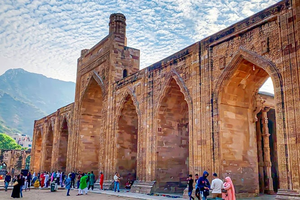Jaipur, May 11 (IANS) Adhai Din Ka Jhonpra, another mosque in Ajmer, has joined the list of controversial monuments after a few Jain seers recently claimed that signs of mythological remains of Sanskrit school and temple are still visible there.
Ajmer Deputy Mayor Neeraj Jain on Saturday also claimed that there has been a Jain temple at this premises and remnants of damaged statues have been found as well.
“Earlier, this place was Saraswati Kanthbharana Mahavidyalaya, which the invaders tried to capture and demolish. In the past too, we had demanded conservation and promotion of this place,” Ajmer Deputy Mayor Neeraj Jain said.
He said that the visit made by Jain monk seer Acharya Sagar confirmed the fact that there was a Jain temple along with a Sanskrit school at this place.
He demanded a survey to be conducted at the place on the pattern of Kashi Vishwanath, Ayodhya and Mathura.
“Illegal encroachment should be removed,” the Deputy Mayor demanded.
Jain said that seer Acharya Sunil Sagar Maharaj during his visit here confirmed that more than a hundred idols were found inside the Parhwanath cave. “There is a need for a survey here too,” said Jain.
The Jain seers with other activists visited the monument two days back.
While talking to the media, Sunil Sagar Maharaj claimed that when he went to the Parshvanath cave, where more than a hundred idols were kept there.
“This means that there must have once been a Jain temple here. These issues should be resolved through mutual understanding. Where there are mosques, they should remain, but where temples etc. have been disturbed, they should be brought back in their ancient form,” Sunil Sagar Maharaj said.
Soon after the seers’ visit, audio of Ajmer Dargah seer Syed Sarwar Chishti went viral in which he was heard saying, “How people went inside Adhai Din Ka Jhonpra without clothes, there is also a mosque inside.”
Assembly Speaker Vasudev Devnani has strongly condemned Chishti’s statement and said that he will write a letter to ASI for a survey here.
On January 9, 2014, Jaipur MP Ramcharan Bohra had written a letter to the Ministry of Tourism and Culture, in which he requested for consideration of converting it to its original form (Sanskrit school and temple).
The monument has a long and quite controversial history behind it. Some historians say that earlier it used to be a huge Sanskrit college, where all the modern subjects were taught in Sanskrit.
When Afghan ruler Mohammad Ghori passed through here, commander Qutubuddin Aibak demolished the Sanskrit college and built a mosque in its place on his orders.
A mixed glimpse of Hindu, Islamic and Jain architecture can be seen in the complex. At present, both Jain and Hindu architectural arts of that time can be seen here.
The building has many literary works engraved on the stones, including excerpts from Lalita Vigraharaja Natika and Harikeli Natika.
On the southern tower, there is an inscription in the name of the construction supervisor Ahmad ibn Muhammad al-Arid. There are 70 pillars 25 feet high, which even today give evidence of the existence of a temple.
Alexander Cunningham who was appointed as Director General of ASI in 1871 has described the building in detail in four reports and said that upon inspecting the site, he found that it was built from the ruins of several Hindu temples.
Its name ‘Adhai Din Ka Jhonpra’ reflects the astonishing speed of its construction and that it was possible only by using free materials found ready from ruins of Hindu temples.
There is a belief that a part of the mosque was made in two and a half days and hence came its name Adhai Din Ka Jhonpra.
A history student Ruchika says today the situation is that most of the temples, forts, and step-wells are victims of encroachment or are in ruins.
“Although the Adhai Din Ka Jhonpra has been preserved since 1919, no government has made any effort to return it to its old glory. Even today, it is testifying to the religious fanaticism of the Muslim invaders,” she adds.
The mosque is one of the oldest in India and is also the oldest surviving monument in Ajmer. Commissioned by Aibak in 1192 CE and designed by Abu Bakr of Herat, it speaks of Indo-Islamic architecture.
–IANS
arc/dan
